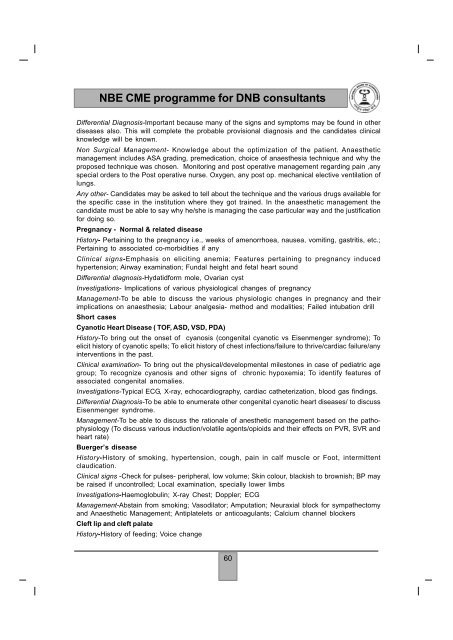NBE CME programme for DNB consultants - National Board Of ...
NBE CME programme for DNB consultants - National Board Of ...
NBE CME programme for DNB consultants - National Board Of ...
Create successful ePaper yourself
Turn your PDF publications into a flip-book with our unique Google optimized e-Paper software.
<strong>NBE</strong> <strong>CME</strong> <strong>programme</strong> <strong>for</strong> <strong>DNB</strong> <strong>consultants</strong>Differential Diagnosis-Important because many of the signs and symptoms may be found in otherdiseases also. This will complete the probable provisional diagnosis and the candidates clinicalknowledge will be known.Non Surgical Management- Knowledge about the optimization of the patient. Anaestheticmanagement includes ASA grading, premedication, choice of anaesthesia technique and why theproposed technique was chosen. Monitoring and post operative management regarding pain ,anyspecial orders to the Post operative nurse. Oxygen, any post op. mechanical elective ventilation oflungs.Any other- Candidates may be asked to tell about the technique and the various drugs available <strong>for</strong>the specific case in the institution where they got trained. In the anaesthetic management thecandidate must be able to say why he/she is managing the case particular way and the justification<strong>for</strong> doing so.Pregnancy - Normal & related diseaseHistory- Pertaining to the pregnancy i.e., weeks of amenorrhoea, nausea, vomiting, gastritis, etc.;Pertaining to associated co-morbidities if anyClinical signs-Emphasis on eliciting anemia; Features pertaining to pregnancy inducedhypertension; Airway examination; Fundal height and fetal heart soundDifferential diagnosis-Hydatid<strong>for</strong>m mole, Ovarian cystInvestigations- Implications of various physiological changes of pregnancyManagement-To be able to discuss the various physiologic changes in pregnancy and theirimplications on anaesthesia; Labour analgesia- method and modalities; Failed intubation drillShort casesCyanotic Heart Disease ( TOF, ASD, VSD, PDA)History-To bring out the onset of cyanosis (congenital cyanotic vs Eisenmenger syndrome); Toelicit history of cyanotic spells; To elicit history of chest infections/failure to thrive/cardiac failure/anyinterventions in the past.Clinical examination- To bring out the physical/developmental milestones in case of pediatric agegroup; To recognize cyanosis and other signs of chronic hypoxemia; To identify features ofassociated congenital anomalies.Investigations-Typical ECG, X-ray, echocardiography, cardiac catheterization, blood gas findings.Differential Diagnosis-To be able to enumerate other congenital cyanotic heart diseases/ to discussEisenmenger syndrome.Management-To be able to discuss the rationale of anesthetic management based on the pathophysiology(To discuss various induction/volatile agents/opioids and their effects on PVR, SVR andheart rate)Buerger’s diseaseHistory-History of smoking, hypertension, cough, pain in calf muscle or Foot, intermittentclaudication.Clinical signs -Check <strong>for</strong> pulses- peripheral, low volume; Skin colour, blackish to brownish; BP maybe raised if uncontrolled; Local examination, specially lower limbsInvestigations-Haemoglobulin; X-ray Chest; Doppler; ECGManagement-Abstain from smoking; Vasodilator; Amputation; Neuraxial block <strong>for</strong> sympathectomyand Anaesthetic Management; Antiplatelets or anticoagulants; Calcium channel blockersCleft lip and cleft palateHistory-History of feeding; Voice change60
















